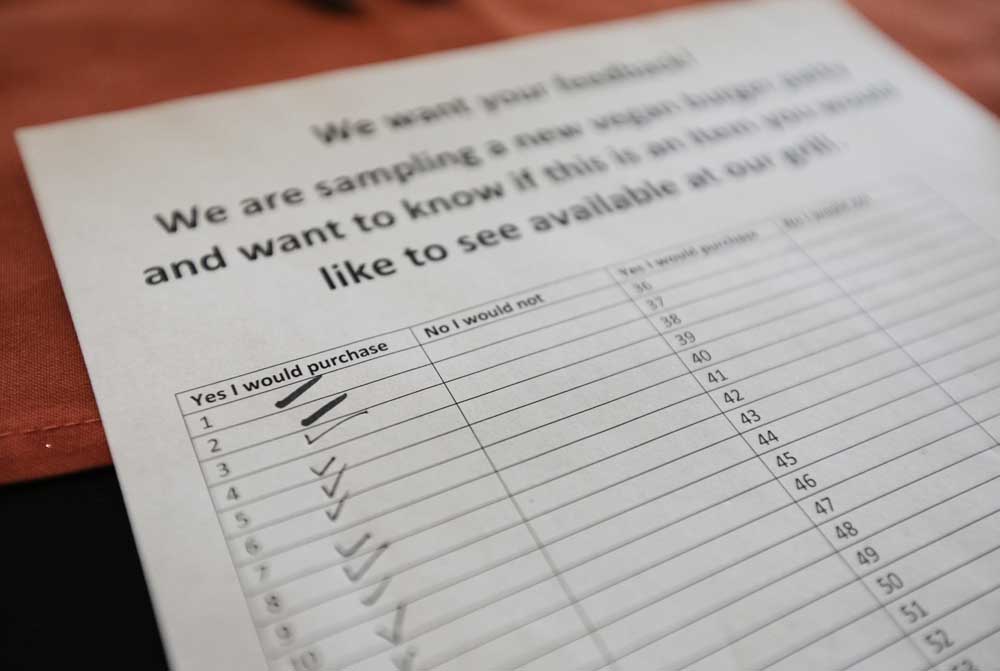OSU-Cascades’ chef crafts healthy, gourmet menus
Published 12:00 am Tuesday, April 10, 2018

- Checkmarks indicate approval for the Beyond Burger samples at the OSU-Cascades dining hall on Thursday, March 8, 2018, in Bend. (Joe Kline/Bulletin photo)
Gone are the days of sliding a tray along a metal rack in a cafeteria line in anticipation of a giant scoop of the daily special.
That industrial-like scene and nondescript foods have been replaced by individual meal-prep stations where students can order a meal tailored to their tastes and dietary requirements.
Trending
The dining hall on a college campus has evolved into a community watering hole for students seeking a quick bite or respite from their studies.
“We eat here pretty often. I’m usually here five days a week, one meal a day,” said Haley Jordan, a senior at Oregon State University-Cascades. “It’s just good (food) and a good price, so I eat here more.”
Dining halls at university campuses across the country have upped their offerings to more global, gourmet fare. This is partly due to more food awareness, but also because dining halls are being used to draw prospective students to colleges and universities.
The Culinary Institute of America and Harvard T.H. Chan School of Public Health have teamed up to create Menus of Change University Research Collaborative, an initiative providing professionals in the food industry with research, menu guidance and business strategies. According to the 2017 Menus of Change Annual Report, “Headlines appeared nearly every week highlighting the great work happening in the college and university sector to introduce students to healthier, more sustainable options, from blended burger competitions to savory breakfast bowls and beyond.”
The Beaver Dam, OSU-Cascades’ food hall, brought in a chef with decades of restaurant experience to head the kitchen on the Central Oregon campus. The university’s goal is to create healthy, tasty options at an affordable price that appeal to young students.
Gourmet-style dining halls
Trending
University of California’s Bruin Plate recently offered grilled pork loin chop with squash and pears. University of Oregon’s Fresh Marketplace has a sushi station where students can order eight pieces of freshly-rolled maki. Portland State University’s Smith Kitchen had Huli Huli chicken and garlic butter shrimp on its rotating menu last month.
Brad Phillips, the chef de cuisine at OSU-Cascades’ Beaver Dam made scallops with potato pedestals, fish roe and Brussels sprouts on a recent day.
“In general there’s a lot more emphasis on dining because eating is important to people, and it can be a factor in what school a person chooses,” said Tara Sanders, Oregon State University’s assistant director of nutrition and sustainability. “I think that many schools have built it into their (campus) orientation.”
The college cafe is attempting to be like a “mini real restaurant” with customizable, high-quality food made by recognized chefs, Phillips said.
Employing talented chefs has improved the overall quality of the food, Sanders said. When you’re responsible for feeding a group of 20-somethings, it’s important that there are enough healthy options.
“People aren’t going to eat healthy just for the sake of eating healthy; it has to taste and look good,” Sanders said.
Additionally, the Beaver Dam draws public patrons in by making high-quality food for an affordable lunch or dinner.
“We have a lot of local businesses, and they come back because it’s a better alternative than, you know, if you go down the street,” Phillips said.
Worth the price
The OSU-Cascades dining program is funded by revenue from the dining services.
“The annual budget for the Beaver Dam in 2017-18, including staffing — management, chef and kitchen staff, and student staff — to cover a seven-day per week, three-meal per day operation, as well as food, beverage and equipment purchases, is $590,000,” Christine Coffin, OSU–Cascades director of communications and outreach, said in a recent email to The Bulletin. Because the university’s dining program doesn’t receive federal funding, the chef is not required to follow any specific guidelines for what’s served or portion sizes. OSU’s chef seeks a wide variety of recipes. He enters meal plans into a food-accounting system that tracks nutritional information, food costs and allergens. The goal at OSU-Cascades is to provide students with wholesome foods that make up a healthy, balanced plate.
Restaurant dishes, student prices
Gyros, fajitas, bahn mi sandwiches, Korean street tacos, loco moco — these are all items Phillips listed on the upcoming menu at the Beaver Dam.
“Oyster po’boy — that’s one that there will be like five people who are really stoked, really happy that they’re going to eat an oyster po’boy; then the rest are like, ‘Eh.’” Phillips said. “So we do things too like that, that are just fun talking points.”
Many colleges are pushing for locally sourced meals, a priority for student diners.
“Consumers are now able to buy local and regional foods not only from restaurants, but also in farmers markets or from their food retailers; furthermore, many have advocated the use of local foods in the burgeoning farm-to-school movement,” according to the Menus of Change report.
OSU tries to use as many Oregon-produced foods as possible. For example, the kitchen uses Camas Country Mill baking ingredients, Strictly Organic coffee, Eberhard’s Dairy products, Big Ed’s Bakery breads, Oregon Valley Natural Beef, Humm Kombucha, Metolius Artisan tea and Agricultural Connections fresh produce.
“They’re high-end, expensive products, and we just try to give a really good value to the students,” Phillips said. “Make it part of why they want to come back and tell a friend.”
Students can eat items that would normally cost $15 to $20 at a restaurant for less than $10 at their campus dining hall.
“We love Cascades dining,” said Zola Nkansah, a financial aid coordinator for the university.
“They make curry, and they have to notify me,” Nkansah said. She can buy a big container of curry for $3, which is enough to feed four people.
V for vegan
Jordan picked up a thick beet burger half and took a close look at it. “It’s weird, it looks like meat,” she said.
“It tastes really good,” said OSU-Cascades senior Sheridan Jeffries, after biting into the dark red patty.
The OSU-Cascades Beaver Dam recently conducted a tasting to get student feedback on a potential vegan entree, a meal option that’s often been requested by student diners. Like Jordan and Jeffries, students lined up for samples of the Beyond Burger, a beet burger patty with garlic aioli, tomato and arugula, served on either a Big Ed’s classic bun or Udi’s gluten-free bun.
Vegans, vegetarians, gluten-free eaters and fast-food lovers all eat in the dining hall on a daily basis. How does one create a menu for them all that is efficient and affordable?
The trick, according to Phillips, is variety. Bar options — like taco, salad or sandwich bars — where students can pick and choose their own toppings — are easy for chefs and students.
“Foods are made-to-order; there’s a lot more individualization that can happen,” Sanders said. “You pick your ingredients and your options rather than, this is what we’re serving today.”
The Beaver Dam has several different stations with rotating menus, including a grill station, global station, pizza station and salad bar.
“Of each of those stations, we have gluten-free and vegan options on all of them,” Phillips said. “You can get a gluten-free pizza crust, we have vegan cheese, gluten-free hamburger buns, veggie burgers, beet burgers, gluten-free tacos.”
“Like me, (students) could eat tacos, burritos, quesadillas pretty much any day of the week,” Phillips said.
The multiple cooking stations within Beaver Dam are used to make a variety of foods. The pizza station can be used to make quesadillas, paninis, sushi or shepherd’s pie. Fish and chips, burgers and pastas can be made at the grill station. The global station can be transformed into a stir-fry bar or a make-to-order ramen section.
“A restaurant: They’re executing their vision,” Sanders said. “We’re executing a menu. Certainly we have permissions and a vision, but we’re tending to a need and those needs can shift.”
— Reporter: 541-383-0351, mcrowe@bendbulletin.com








